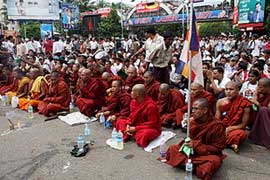
|
|
|
Home Asia Pacific South East Asia Myanmar Myanmar Protest News A junta synonymous with horrorBy PHILIP J CUNNINGHAM, The Bangkok, Post, Oct 12, 2007
Even as one of the world's great humanitarian struggles fades from the TV screen, the Burmese people are at risk of being felled like trees in a far-off forest Bangkok, Thailand -- After years of frustrating quietude, Burma's long-simmering discontent has broken out into an open boil. A daring spiritual protest was followed by a cruel and callous bloodletting, the kind of event that brings out the best and worst of the global media.
Such footage was obtained under trying conditions and supreme personal risk, the work of intrepid individuals willing to forsake comfort and safety to tell a story that needs to be told. Compelling images, enhanced by an exotic setting, captured the gist of the Burma story. It is in the nature of the medium to focus on stories with good visuals; indeed television news at its most engaging is packed with sights and sounds that not only awe but educate.
Then the screen went dark, as Buddhist monks, the penultimate moral authority in the orthodox Theravada Buddhist culture of Burma, were shot at and beaten in scores, cameras confiscated and thousands of witnesses and participants put under lock and key. Despite the momentary lull, the crackdown bodes ill for the superstitious Than Shwe kleptocracy that has until now been able to rule Burma with an iron fist, because even the military, through its mindful cultivation and supervision of the Buddhist clergy, would be the first to admit that no good karma can come from the killing of monks. By the same token, no good can come of the killing of journalists, who collectively, despite individual imperfections and failings, serve as a lay clergy of sorts, moral arbiters for much of the world outside of closed countries like Burma, from Moscow to Baghdad, from Johannesburg to Japan. When Burma reinvented itself as Myanmar after the bloody massacre of Burmese students in 1988, the Japanese media, like the blindly politically correct CNN, embraced the unhappily revised status quo with such linguistic zeal that a Tokyo-based reporter would have to argue with editors to use the word ''Burma'' rather than ''Myanmar'', even, absurdly, in at least one instance, in an article that made reference to George Orwell's Burmese Days. But the cold-blooded on-camera killing of Japanese journalist Kenji Nagai on Sept 27, 2007 as he filmed the unfolding of a protest in the streets of Rangoon, has shocked and galvanised the Japanese media, even the quasi-governmental NHK, enough to cause Japan's ''neutral'' stance to be reconsidered. As the regime that calls itself ''Myanmar'' becomes synonymous with horror, the old word ''Bi-ru-ma'' the Japanese rendering for Burma, is likely to make a comeback. That the killing of a single Japanese citizen has provoked more outrage than the deaths of a dozen unknown local demonstrators speaks partly to the tribal nature of the media in today's world, but also points to the importance of access and the elements of good story-telling. Nagai's story can be shared effectively because documented facts and images exist that make a rounded telling possible. His parents and co-workers were interviewed, his camera work put on view. But even allowing for bias in the coverage, Nagai's fate was not only supremely newsworthy, but appropriately paired with the pain and loss suffered by dignified Burmese monks and civilian demonstrators. Kenji Nagai was shot in the back while doing his job, his body and passport returned but not his camera. Through him, the world got a shocking glimpse of Burma's shoot-to-kill politics. Even a casual TV viewer fuzzy on the details _ and who isn't, given the dearth of information coming out of Burma _ can see that there is something terribly wrong about a regime that operates in such a way. The brutal imagery of people with guns gunning down people without guns speaks for itself. If it bleeds, it leads. Long the mantra of the tabloid press and TV stations desperate to find an audience, these callous words might as well be the mantra for the global cable and network giants. CNN and other news giants have done a decent job using other people's footage to catch up with a story that took the world by surprise in part because of their own negligence, bestowing Burma with 15 minutes of fame and then a bit more. But few if any card-carrying cable stars and camera crews can get into Burma, effectively putting the story back on the back burner. Photos posted to the internet strain to fill the gap, and a range of motley voices from refugees and militant minorities to a handful of bloggers inside Burma have tales to tell, but bloggers are not journalists and verification remains vague. Even as one of the world's great humanitarian struggles fades from the screen, the 24/7 news show must go on. Entertaining practitioners of TV journalism will while away valuable air-time as before, inadvertently focusing on the celebrity of celebrity, re-directing attention away from the afflicted to the affluent and their own fastidiously groomed selves. Meanwhile, as Burma, the land once lovingly described by Kipling as full of ''sunshine, palm trees and tinkly temple bells'', recedes from view, its people are at risk of being felled like trees in a far-off forest, invisible and all but unheard. ----------------------- |
 Get your Korean Buddhist News here, brought to you by BTN-Buddhist Channel |
 |
 The Mandala app brings together Buddhist wisdom and meditation techniques with the latest insights of psychology and neuroscience to handle the challenges and complexities of modern life. The App offers a series of engaging talks and conversations with experts on a wide variety of topics, such as managing stress, dealing with adversity, developing greater resilience, cultivating empathy and compassion, creating healthy relationships, and many more. These topics are explored to help find greater peace, meaning and joy in our lives. Our panel of experts include Dr, Thupten Jinpa, Daniel Goleman, Kelly McGonigal and others.FREE DOWNLOAD here |
| Point
your feed reader to this location |
| Submit an Article |
| Write to the Editor |

 The uplifting image of maroon-robed barefoot monks with upturned alms bowls gliding down grubby Rangoon streets surrounded by masses of adoring civilians was the penultimate performance art, created by anonymous thousands, hand-delivered to journalists as a gift to a jaded world.
The uplifting image of maroon-robed barefoot monks with upturned alms bowls gliding down grubby Rangoon streets surrounded by masses of adoring civilians was the penultimate performance art, created by anonymous thousands, hand-delivered to journalists as a gift to a jaded world.